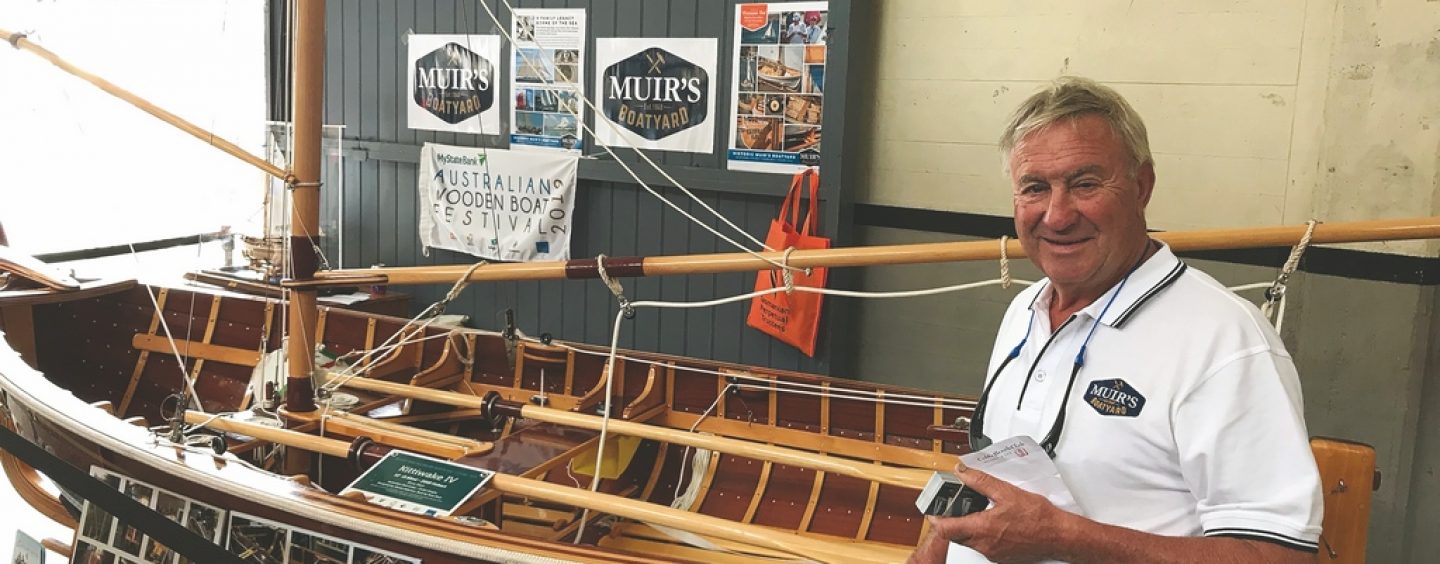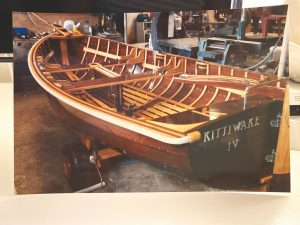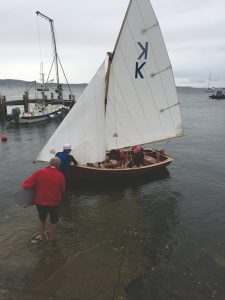Ross Muir showing Kittiwake IV at the 2019 Wooden Boat Festival in Hobart
Story by Sarah Schwaner
Local boating legend Ross Muir has done it again. After 500 plus hours of careful and meticulous crafting, amazing workmanship, and paying homage to his family’s sailing history, Ross has built Kittiwake IV. A 12-foot cadet dinghy built of Australian Red Cedar and Huon Pine, with the oars, mast, boom and gaff being of Canadian Spruce, Kittiwake IV was built in 2018 and displayed at the 2019 Wooden Boat Show in Hobart. One of the oldest design classes in Australia, the Tasmanian 12-foot cadet dinghy has three crew, and is rigged with a mainsail, jib and spinnaker. Originally designed to influence youth to sail and compete, the dinghy has continued to do so with 2021 being the 91st Stonehaven Cup, as none were held during world war 2.
In 1927, the first Stonehaven Cup was held. By 1933, Jock Muir, Ross’s father, had won with his boat Kittiwake. The same boat went on to win two more times in 1935 and ‘38. In 1963, Ross built Venom and went on to win the cup in 1964. Two years later Jock built Kittiwake II and Greg, Ross’ brother, won the cup in 1967. The list of Muir entries and winnings of the Stonehaven Cup seems to be endless. With the first Kittiwake being built in 1932, and Kittwake III built by Jock Muir and apprentices in 1976, and the fourth Kittiwake being built in 2018, the history of the name, both Muir and Kittiwake, continues. Ross built Venom in 1963 in Hobart as part of an apprenticeship and raced it the following year.
Winning the cup, Ross was invited in March of 1974 to celebrate, along with other previous victorious skippers, the 50th anniversary of the first interstate race for the 12-foot cadet dinghy. The Royal Yacht Club of Tasmania, RYCT, was lucky enough to be the host of this wonderful event. Teams from South Australia, Victoria, and Tasmania competed, with Tassie winning by one quarter of a point. Later that afternoon another race was held between 13 Stonehaven Cup helmsen who had won the Cup previously. Ross raced Falcon, Jock raced Narranda, and Greg raced Flight. Though the Muir family didn’t win that one, the original winner of the first race held in this class in 1925, Archie Robertson, did – making the 50th anniversary that much more special.
Ross went on to build two more 12” cadet dinghies after Venom: Red Jacket in 1966 and Narranda in 1969. When asking him what made him want to build Kittiwake IV, Ross said it “was a passion to build another 12-foot dingy” the way it was when he was a teenager.
In the late 1970’s the last timber Tasmanian 12-foot cadet dinghy was built. Fiberglass arrived and then eventually the Marconi rig replaced the gaff rigged fore-and-aft sails. This makes the Kittiwake IV especially special and rare because it’s the first one of its kind built in over 40 years. It was also the only one at the Wooden Boat show in 2019.
The first cadet dinghy built in Tasmania was Pierrette, constructed by Charles Lucas at Battery Point in the early 1920’s. Rex Willing paid £35 for her and kept her moored off of his slip. She was used by her crew to run errands to ship-chandlers for Lucas’ shipyard. In 1924, the first race using these dinghies was held. The race was held on the Derwent River and involved two boats: Hermione, sailed by G. Murdoch of NSW, and Pierrette, sailed by H.P. Newman of Hobart – it ended in a tie. Not long after this initial race the second interstate championships were held in Port Adelaide, South Australia, making it the next state to take up the class. It wasn’t until 1927 that Lord Stonehaven, the Governor General of Australia, donated to the class a cup for interstate competition. This gift solidified the 12-foot cadet dinghy’s place in Australian sailing and was the beginning of almost 90 years of history. While other states have tried their hand at participating, Victoria, South Australia and Tasmania are the only states with active fleets.
Ross Muir’s Kittiwake IV is an absolutely stunning piece of craftsmanship. Beautiful Australian Red Cedar inviting you in from the outside, Huon Pine lined around you and at your feet, and Canadian Spruce above you and in your hands as you row, the 12-foot cadet dinghy is a work of art. It’s understandable Ross wanted to build a boat that reminded him of being a kid and where he learned a few things about sailing. But I think too that Ross wanted to build something beautiful, a piece of art that needed to be remembered and brought back to life. And, mostly, a piece of history from his home that was the training grounds for so many young sailors throughout the last 100 years.
































